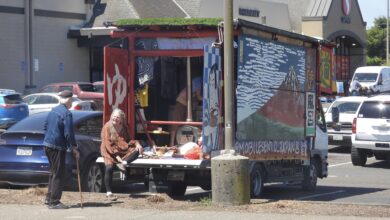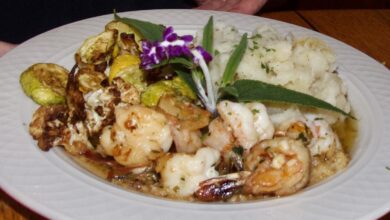Hatchery fish are key to salmon survival
Kori Roberts has a seasonal job that might sound like a horror movie script. She collects heads in Noyo Harbor for the Department of Fish and Wildlife, going to commercial and private boats to saw them off, bag them and carry them away in a cooler. The DFW sends the king salmon heads to a laboratory in Santa Rosa to study them, so that migratory behavior of the big pink fish can better be understood. She takes only the heads of those with adipose fins cut off.
California’s hatcheries cut the adipose fin off of one quarter of the fish that leave for the ocean. Those clipped fish also have coded pieces of wire inside the head that tell their exact point of origin. Don’t look for the wire, it’s microscopic- one millimeter long, said Jennifer Simon, environmental scientist for the Department of Fish and Wildlife’s Ocean Salmon Project. Each tiny tag contains a binary code that identifies a specific release group of salmon including species, run, brood year, hatchery or wild stock, release size, release date and release location.
Wild Chinook (king) populations are rare in California, meaning most fish caught in oceans or rivers originated from hatcheries. Hatcheries release their own gathered wild stock as well as hatchery stock.
Although the Ocean Salmon Project was launched in 1962 to study salmon, a lot of new information has been gathered by the insertion of the tracking wires beginning in 2006. That added head collecting and refrigerating to the job description of the crews. They are part of a CDFW crew of about five people that work out of Noyo Harbor on the Ocean Salmon Project, which is funded by operators of the dams that blocked salmon from most of their ancestral habitat. There are about 40 people working in the program at 20 ports around the state, Simon said. The crews are familiar sights for every commercial fisherman and party boat, as well as many of those who use the eastern boat ramp in Noyo Harbor. Other agencies also gather the heads in other places. Laboratories in Santa Rosa and Sacramento have both been expanded and are able to process the 50,000-70,000 heads recovered annually from ad-clipped salmon observed during migration of smolts out to the ocean and California ocean and river fisheries monitoring, CDFW reports state.
Fishermen are a key link in providing not just fish heads, but important information about salmon to the CDFW. Rich Holmes and Laura Miller caught a strange Chinook hatchery salmon on their boat The Animal Fair and called the Department of Fish and Wildlife to investigate. What was unusual was that the color and body aging of the fish made it appear like a fish that had already migrated up a river to spawn. But the female salmon was caught in the ocean. Miller said the duo caught a male hatchery salmon a few years ago which also appeared to be a ripe “river salmon.”
This reporter contacted a half dozen salmon experts, who could not help much without the picture. They all said some salmon do odd things. Simon said some salmon do develop earlier than others and the find while rare, was not something new or surprising to researchers. In the Central Valley, some salmon end up in rice fields rather than their ancestral river.
Part of the problem is the thrilling but overly simplified elementary school narrative everybody learns about salmon. They swim down a river, live in the ocean for three to four years, then return to the exact same spot. True for most, but not all. Some salmon don’t follow the pattern, or even the other salmon. Some “stray” or go to a different river than where they came from. Salmon texts say straying is as natural a behavior as homing.
Straying increased with recent successful hatchery trucking programs. Many salmon are transported from their hatcheries to the Delta, avoiding rivers that have become too warm, too toxic and invasive species-infested.
One expert suggested the fish might have been a sockeye salmon, although that fish is almost never found this far south. That turned out not to be so. There are five varieties of salmon in Alaska. The two of these also found in California, Coho and Chinook, are the most desirable among fishermen. Fishing for silver or Coho salmon is illegal as they are a protected species. Coho salmon can be quite common off Fort Bragg. Hikers who see salmon migrating in local forest streams are generally seeing Coho. Experts attribute the decline of the Coho, from an important commercial fish as late as the 1970s, to an endangered species, to logging practices, not overfishing. Coho salmon have been bouncing back, with the population tripling along the Mendocino Coast from 1990s lows.
Very rare is a catch of sockeye in the ocean in California. Surprisingly, fishermen are allowed to keep this rare fish. That’s because any salmon caught in California that is not a Coho or Chinook is considered a stray. Fishing regulations say fishermen can keep any salmon they catch (subject to seasons and bag limits) that is not a Coho.
The Chinook catch out of Noyo Harbor got off to a great start in May, but has been terribly disappointing to commercial and recreational ocean fishermen in July and August, a half dozen fishermen who were interviewed said. However, Simon, with a statewide perspective and access to actual statistics, said the commercial harvest has been better than predicted this year. She said the recreational take has been less than anticipated. That could be because salmon seem to be found deeper and further offshore this summer, she said, making them harder for small boats to find.
Although the program of implanting coded wires has been in existence for nearly a decade, the salmon didn’t come back for 2-4 years after first having the wires inserted.
The release of information by CDFW is several years behind, making the information still “new”. The newest available statistics are from 2011. Because salmon numbers gyrated wildly during the early life of the program, the extremes involved mean data gathered has limited broader meeting. Officials hope the information can eventually play a big part in everything from genetics to riparian restoration.
California hatcheries today produce more than 50 million salmon and steelhead each year. Only about 1 percent return to spawn. Hatcheries have been used to deal with declining salmon populations for more than a century. Baird Hatchery on the McCloud River in California was opened in 1872. Most hatcheries were established in the mid-20th century after dams were built all over the West, cutting off 80 percent of the historic spawning grounds.
Hatcheries and programs like the Ocean Salmon Project are funded by dam operators. Simon says that steady funding source has given the program long-term continuity and more than a half-century of data. The wire-tracking program, on the other hand, has had to search for continued funding.
Hatcheries have saved the West’s salmon population but have also produced problems that have been getting worse in recent years. The wild dips in the migratory salmon populations in recent years have been attributed to genetic weaknesses in hatchery salmon, making it difficult for the fish to survive changing ocean conditions. Salmon have suffered losses of important genetic alleles that may be important to its long-term survival. Hatcheries are being modernized to upgrade genetic management but challenges remain. A newer tribal hatchery, the Chief Joseph Hatchery in Washington state, was launched with a sophisticated DNA and genetics program that follows the results of several panels that have studied the issue of genetic problems in salmon created by more than a half century of hatchery use.
Annual reports of ocean salmon catch and fishing effort, along with economic and spawning escapement data, is available from the Pacific Fishery Management Council.
To find Fort Bragg commercial catch and effort on that site, see Appendix A. The data retrieved from coded-wire tags from these fisheries is available through the Regional Mark Processing Center, a centralized database hosted by the Pacific States Marine Fisheries Commission. An analysis of Central Valley coded-wire tags recovered from ocean fisheries is available for 2011, with a 2012 report due to be released sometime later this year. “Recovery of Coded-Wire Tags from Chinook Salmon in California’s Central Valley Escapement and Ocean Harvest” can be downloaded from the Department of Fish and Wildlife’s document library.




